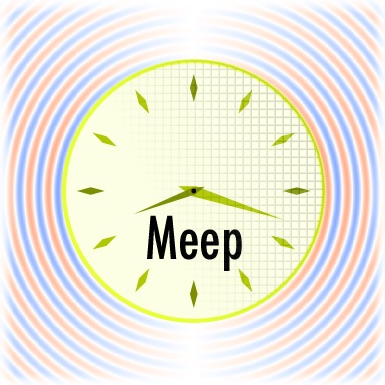 In this RCE podcast, Brock Palen and Jeff Squyres discuss MEEP, a free finite-difference time-domain (FDTD) software for electromagnetic simulations. Their guests are Dr. Steven G. Johnson and Dr. Ardavan Oskooi.
In this RCE podcast, Brock Palen and Jeff Squyres discuss MEEP, a free finite-difference time-domain (FDTD) software for electromagnetic simulations. Their guests are Dr. Steven G. Johnson and Dr. Ardavan Oskooi.
“Meep is a free and open-source software package for simulating electromagnetic systems via the finite-difference time-domain (FDTD) method. Meep is an acronym for MIT Electromagnetic Equation Propagation.”
A time-domain electromagnetic simulation simply evolves Maxwell’s equations over time within some finite computational volume, essentially performing a kind of numerical experiment. This can be used to calculate a wide variety of useful quantities. Major applications include:
- Transmission and Reflection Spectra — by Fourier-transforming the response to a short pulse, a single simulation can yield the scattering amplitudes over a wide spectrum of frequencies.
- Resonant Modes and Frequencies — by analyzing the response of the system to a short pulse, one can extract the frequencies, decay rates, and field patterns of the harmonic modes of lossy and lossless systems including waveguide and cavity modes.
- Field Patterns (e.g. Green’s functions) — in response to an arbitrary source via a continuous-wave (CW) input (fixed-ω).
Meep’s scriptable interface makes it possible to combine many sorts of computations along with multi-parameter optimization etcetera in sequence or in parallel.
Steven G. Johnson is a Professor of Applied Mathematics and Physics at MIT. He works in the field of nanophotonics—electromagnetism in media structured on the wavelength scale, especially in the infrared and optical regimes—where he works on many aspects of the theory, design, and computational modeling of nanophotonic devices, both classical and quantum. He is coauthor of over 200 papers and over 25 patents, including the second edition of the textbook Photonic Crystals: Molding the Flow of Light. In addition to traditional publications, he distributes several widely used free-software packages for scientific computation, including the MPB and Meep electromagnetic simulation tools and the FFTW fast Fourier transform library (for which he received the 1999 J. H. Wilkinson Prize for Numerical Software).
Ardavan Oskooi is the Founder/CEO of Simpetus, a San Francisco based startup with a mission to propel simulations to the forefront of research and development in electromagnetics. Simpetus is a reference to our vision for simulations being an impetus for new discoveries and technologies. Ardavan received his Sc.D. from MIT where he worked with Professor Steven G. Johnson (thesis: Computation & Design for Nanophotonics) to develop Meep. Ardavan has published 13 first-author articles in peer-reviewed journals and a book “Advances in FDTD Computational Electrodynamics: Photonics and Nanotechnology”. Ardavan has a master in Computation for Design and Optimization from MIT and completed his undergraduate studies, with honors, in Engineering Science at the University of Toronto. Prior to launching Simpetus, Ardavan worked as a postdoctoral researcher with Professors Susumu Noda at Kyoto University and Stephen R. Forrest at the University of Michigan on leveraging Meep to push the frontier of optoelectronic device design.




